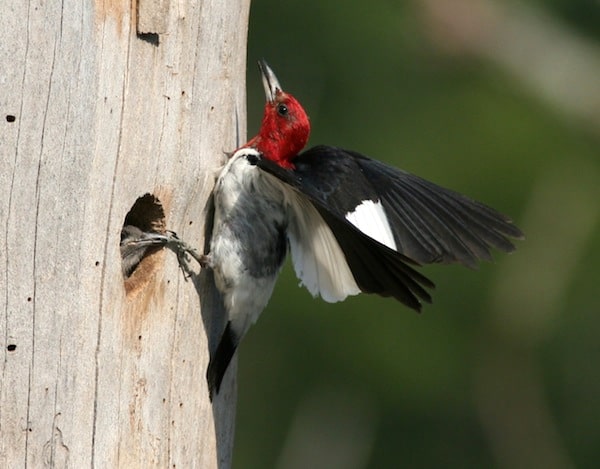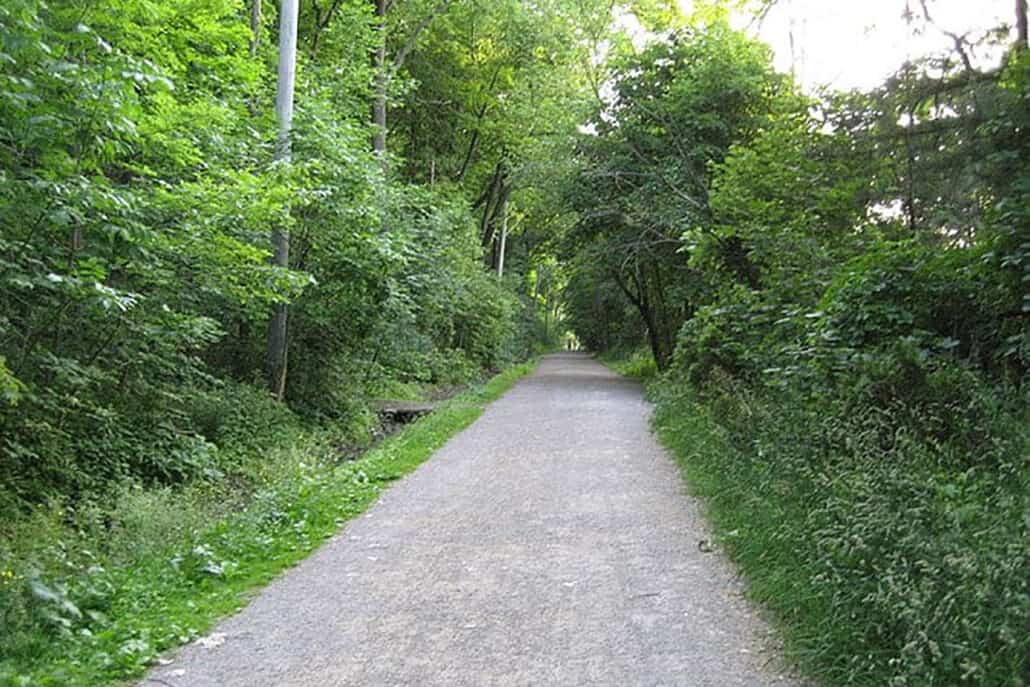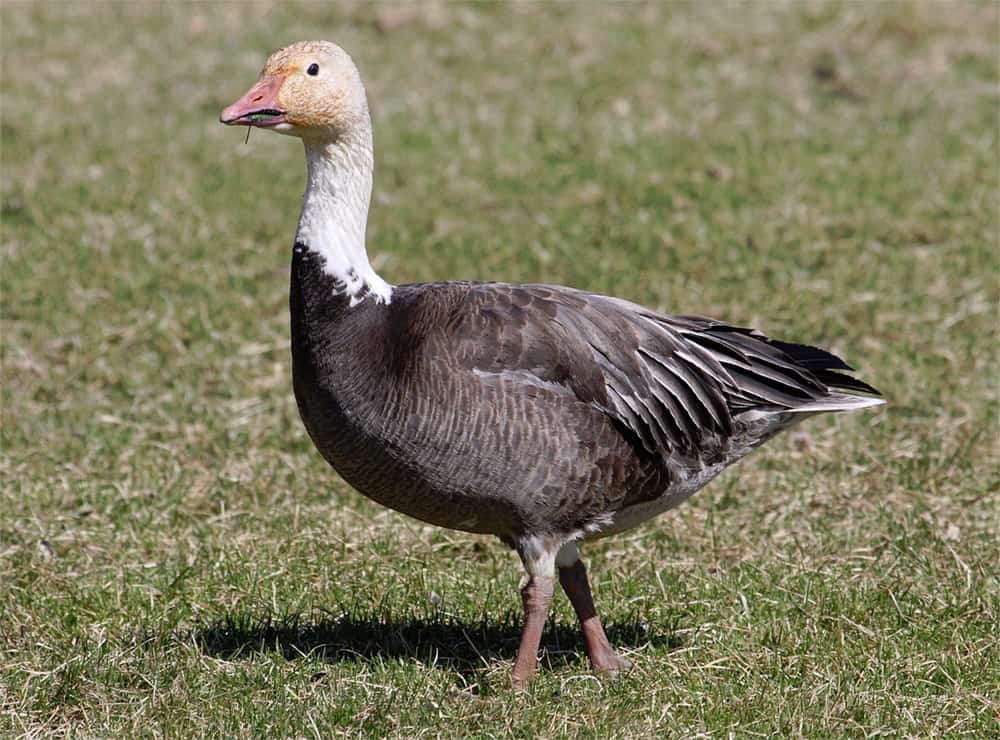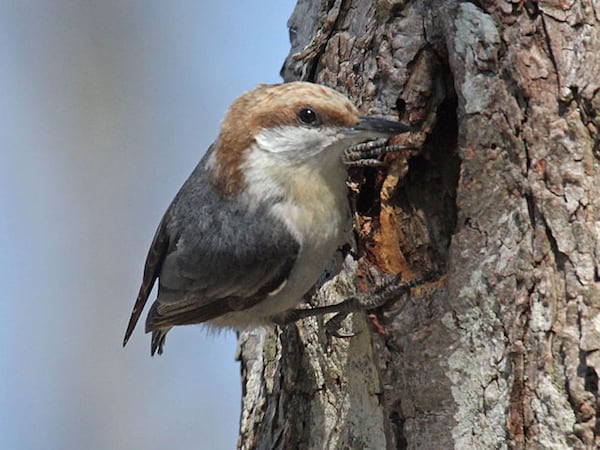Indiana, according to the state motto, is the “crossroads of America.” Travelers from the East, Northeast, or even Southeast who go to Chicago or beyond cross Indiana. And, of course, travelers from Chicago or farther west going east also cross the state. People from Michigan, Wisconsin, and Ontario cross Indiana going to Florida—many of them to spend the winter and cross it again returning home in spring. Many birds, too, cross the Hoosier State when they migrate south in fall and again when they fly north in spring.
Indiana could also be called a meeting place for birds and plants. There are birds that are common to the East, to the North, to the South and some that are usually seen farther west.
To the earliest explorers going west and to the trappers and settlers who followed, most of the territory that became the state of Indiana was forested. It was a land of Indians and white-tailed deer, turkeys and ruffed grouse. The trees that shaded those early travelers were the same as the trees they had been traveling through in Ohio: maples and beech, chestnut, sycamore, tulip, cottonwood, willows, and many more.
In the northern part of the territory were also trees that were common in Michigan, pines and spruces. Where the land was poorly drained in the north there were tamaracks. In swampland along the Ohio River in the South there were those well-known trees of the South, bald cypress.
As those early travelers continued west, if they noticed the species of trees they would have found that the maples and beech in the central and northern part of the territory became more scarce and that oaks and hickories increased. In the west-central part of the state, near the line that now separates Indiana and Illinois, they would have emerged in places from the forest and entered the tallgrass prairie. To the north they would have encountered swamp, then extensive wetlands with tracts of prairie. As they struggled through the swamps and marshes in summer they would have been plagued by hordes of mosquitoes. Those who managed to get through this inhospitable area would have come to a series of ridges, then, at the far north, sand dunes and finally the shore of Lake Michigan.
Being a land of forest, Indiana was a land of forest birds. There were thrushes and warblers, vireos and woodpeckers. There were turkeys and ruffed grouse. Early settlers were said to be able to shoot turkeys from the windows of their cabins.
Great flocks of passenger pigeons flew over the state, landing at times to feed on beech nuts and to roost at night. On the wetlands of the northwest in spring and fall there were flocks of ducks, geese, and shorebirds. Some of these birds stayed and nested in the state. Sandhill cranes and a few whooping cranes nested in the wetlands of northern Indiana. Greater prairie-chickens nested in the prairies.
According to Russell Mumford and Charles Keller in The Birds of Indiana, there were Carolina parakeets in southern Indiana. There is no record of ivory-billed woodpeckers being seen in Indiana but there is one specimen in the Miami County Museum in Peru, Indiana that may have been collected in the state along the Ohio River.
John James Audubon visited southern Indiana on at least four occasions; in 1807, 1810, 1819, and 1822. Alexander Wilson, sometimes called the father of American ornithology, was in Louisville, Kentucky, in March 1810 and must have at least visited Indiana.
Prince Maximillian, a Prussian immigrant and early naturalist, spent five months in Indiana. He wrote and published many papers about the birds of America and some of his articles described birds he saw and collected while living in Indiana.
The first book about birds of the state was written by Amos William Butler and published in 1898. Butler is forgotten, except by students of Indiana bird lore. But another Indiana writer, Gene Stratton-Porter, also provided information about birds in the state. In her stories of the Limberlost, a swamp that existed in the east-central part of the state near Geneva, Porter named many of the birds of that area. One of her books is about a single species, the one that became the state bird—the cardinal. Interestingly, one of the birds she described is the black vulture, a bird that no longer nests in that area though it still nests farther south.
Descriptions of the topography of Indiana generally divide it into three regions, north, central, and south. All but the center of the south region were covered by glaciers that modified the terrain and, as they melted, left behind a mixture of soils, scattered rocks, drumlins, moraines, and depressions that became small lakes.
The north region is low hills or flat land. Here are many small lakes and in pioneer days there were many more. Much of the western part of this area was poorly drained. That was an area of swamps and marshes and tracts of tall grass prairie.
The central region is even more flat than the north. This was an area of deciduous forests with prairie at the western edge. It was a land of woodland birds. Pioneers who left any record reported that turkeys and ruffed grouse were common. In the northeast part of this region was the Limberlost, the swamp made famous by Gene Stratton-Porter.
The south region is more rugged. There are hills and hollows, bluffs and ravines. There are a number of caves. The most famous of the caves are the Wyendotte and Marengo.
Hoosier National Forest is in southern Indiana. Clark State Forest, Harrison-Crawford State Forest, Ferdinand, Pike, and Yellowwood State Forests are in southern Indiana. Brown County, Clifty Falls, McCormick’s Creek, Spring Mill, and Shades state parks are in the south.
There are three National Wildlife Refuges in Indiana, Big Oaks, Muscatatuck, and Patoka River. All three are in the southern part of the state.
Settlement brought clearing and, in the north and central sections of the state, draining. Farms and villages were established, then towns and cities. Forest in the north and central regions and in part of the south was reduced to farm woodlots and woods along streams and rivers. The Grand Kankakee Marsh in the northwest and Gene Stratton-Porter’s Limberlost in the east-central region were drained. Corn and wheat, then corn and soybeans replaced the trees where the land was level enough for cultivation. Where the land was too hilly for cultivation it was often used as small dairy farms with pastures and hayfields.
Woodland birds decreased in Indiana. The passenger pigeon and Carolina parakeet disappeared, not just in Indiana, of course, but everywhere. Wild turkeys, ruffed grouse and white-tailed deer were gone, too, though not extinct. Bald eagles no longer nested in the state though a few were occasionally seen, usually along the shore of Lake Michigan. Prairie-chickens were still seen at one small bit of remaining prairie into the 60s, then they, too, were gone. Ducks and geese decreased.
Sandhill cranes stopped nesting in the state. Some still gathered at a remnant of marsh in the northwest in spring and fall but their numbers were counted in hundreds where there had been thousands. Whooping cranes not only no longer nested in the state, they were gone from Indiana. Whooping cranes almost followed the passenger pigeon and Carolina parakeet into extinction.
Remnants of the original cover remain in Indiana, however, and so do most of the bird species. Some of those remnants are protected today in state parks and forests, in state fish and wildlife areas and nature preserves. There are the Hoosier National Forest, Lake Michigan National Lakeshore, and the three National Wildlife Refuges.
The Nature Conservancy, ACRES, a Fort Wayne-based organization, and other private organizations have acquired and are preserving or restoring natural areas. A group named Friends of the Limberlost is acquiring bits of land that were once part of the broad swampland that Gene Stratton-Porter wrote of and are reflooding sections, attempting to reestablish that habitat.
Its location and the remaining and reestablished natural areas still make Indiana a meeting place for the ranges of birds of east, west, north and south. The nesting area of the black-capped chickadee, a more northern-nesting species, meets and overlaps the range of the closely related Carolina chickadee of farther south. Scarlet tanagers nest in Indiana and, in the southern part of the state, so does the summer tanager. Prothonotary warblers and golden-winged warblers nest in the Hoosier State. Pileated woodpeckers have increased and spread and now nest across the state. Wild turkeys and ruffed grouse and white-tailed deer have been successfully reintroduced and are now numerous enough that there are hunting seasons for them.
Eastern meadowlarks are the more common meadowlark in the state but western meadowlarks are occasionally found in the northwestern corner of Indiana. Horned larks nest here, and dickcissel nests have been found. Yellow-headed blackbirds have been seen in the northwest part of the state.
Forty years ago a few hundred sandhill cranes gathered in spring and fall at the Jasper-Pulaski State Fish and Wildlife Area in northwest Indiana. But sandhill cranes have increased since then. Now several thousand gather in spring and as many as 30,000 have been seen in fall at J-P, as the area is called by Hoosier birders. A few sandhill cranes now nest in the northern part of the state. It’s good to have such an impressive creature nesting in Indiana once again.
Bald eagles and peregrine falcons have been reintroduced and nest once more in Indiana. Whooping cranes are being hatched and raised in captivity and some of them have been taught to follow ultralite aircraft at the Necedah National Wildlife Refuge in Wisconsin. From there, they are led by the planes in fall across Indiana, south to the Chassohowitzka National Wildlife Refuge in Florida. One stopping point on their journey south has been the Muscatatuck National Wildlife Refuge in Indiana.
From Florida the whooping cranes of Necedah and Chassohowitzka return in spring, on their own, to Wisconsin. A few have been seen with sandhill cranes in spring in Indiana, and many Hoosier birders eagerly watch for their passing.
In Indiana Birds and Their Haunts, published in 1979, Charles E., Shirley A. and Timothy C. Keller wrote that 363 species of birds might be seen in Indiana and that 166 species nested there. Those numbers have increased in the ensuing decades. “Splitting” of species by the naming committee of the American Ornithologists Union has caused part of this but vagrant birds have also turned up and been added to the state bird list.
One of those strays was a groove-billed ani, spotted on the campus of Taylor University in Upland, Indiana. It was there several days. My wife and I were two of the many people who saw it as word of its presence spread among bird watchers. There was talk of trying to trap the bird and send it south before it succumbed to the Hoosier winter. But the bird disappeared before anything was done.
Other rare and improbable birds, at least in Indiana, that have been seen here are Pacific loon, Ross’s goose, Eurasian wigeon, king eider, Mississippi kite, pomarine, parasitic and long-tailed jaegers, laughing, Thayer’s and Franklin’s gulls, scissor-tailed flycatcher, northern shrike, Kirtland’s warbler, and Le Conte’s and clay-colored sparrows. Even magnificent frigatebirds have been found in Indiana. One was seen along the shore of Lake Michigan and one was shot in Shelby County in south-central Indiana in 1896 according to Butler.
Indiana, it seems, lives up to its title as The Crossroads of America for both people and birds. And it’s a meeting place of birds and bird watchers from north and south, east and west.




